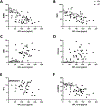Plasma neurofilament light in Huntington's disease: A marker for disease onset, but not symptom progression
- PMID: 33940564
- PMCID: PMC9083556
- DOI: 10.1016/j.parkreldis.2021.04.017
Plasma neurofilament light in Huntington's disease: A marker for disease onset, but not symptom progression
Abstract
Objective: To investigate whether plasma NfL levels correlate with clinical symptom severity in premanifest (PM) and manifest HD (HD) individuals, and whether a NfL cut-point could distinguish PM from HD patients with reasonable accuracy.
Method: 98 participants (33 control, 26 PM, 39 HD), underwent blood sample collection and clinical assessment, using both UHDRS and non-UHDRS measures, at one academic HD Center. Years to onset (YTO), probability of disease onset in 5 years, and predicted years until 60% onset probability were also calculated. NfL levels were measured using a Meso Scale Discovery assay.
Results: Cohorts differed by age. NfL levels differed significantly across diagnostic groups and were significantly correlated with age. Age-adjusted NfL levels were not correlated with clinical measures in either HD or PM cohorts, but were correlated when cohorts were combined. In PM subjects, NfL levels correlated with YTO, probability of onset in 5 years, and years until 60% onset probability. Using ROC analysis, a NfL cut-point of <53.15 pg/ml distinguished HD from control; <74.84 pg/ml distinguished HD from PM.
Conclusions: These findings implicate plasma NfL as a peripheral prognostic marker for premanifest-HD. Notably, we show that significant correlations between NfL and clinical symptoms are detected only when PM + HD subjects are combined, but not within HD subjects alone. To date, prior studies have investigated the clinical usefulness of NfL exclusively in merged PM + HD cohorts. Our data suggests a biasing of these previous correlations, and hence potentially limited usefulness of plasma NfL in monitoring HD symptom progression, for example, in clinical trials.
Keywords: Biomarker; Blood; Huntington's disease; Neurofilament light; Plasma.
Copyright © 2021 The Author(s). Published by Elsevier Ltd.. All rights reserved.
Conflict of interest statement
Declaration of competing interest
The authors declare that they have no known competing financial interests or personal relationships that could have appeared to influence the work reported in this paper.
Figures



References
-
- Andresen JM, Gayán J, Djoussé L, Roberts S, Brocklebank D, Cherny SS, , US-Venezuela Collaborative Research Group, HD MAPS Collaborative Research Group, Cardon LR, Gusella JF, MacDonald ME, The relationship between CAG repeat length and age of onset differs for Huntington’s disease patients with juvenile onset or adult onset, Ann. Hum. Genet 71 (3) (2007) 295–301. - PubMed
Publication types
MeSH terms
Substances
Grants and funding
LinkOut - more resources
Full Text Sources
Other Literature Sources
Medical

